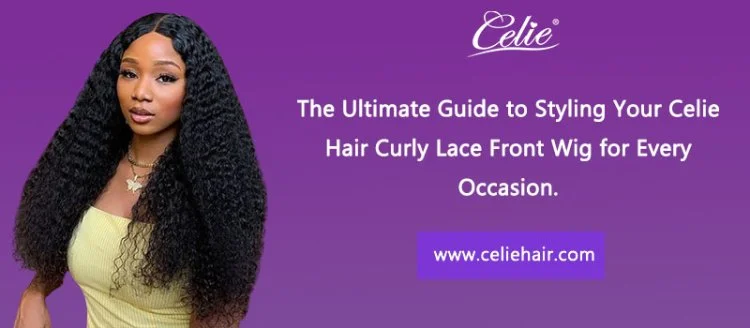The Ultimate Guide to Styling Your Celie Hair Curly Lace Front Wig for Every Occasion.

Before diving into styling, it’s crucial to understand the basics of your wig. Celie Hair curly lace front wigs are known for their high-quality craftsmanship, realistic appearance, and the seamless way they blend with the natural hairline, thanks to the fine lace front. These wigs are typically made from human hair, offering the flexibility to style them with heat tools, just like your natural hair.

Daily maintenance.
Maintaining a Celie curly lace front wig requires a blend of careful handling, proper washing, and regular conditioning to ensure it remains in pristine condition, retaining its luscious curls and natural appearance. Here’s a more detailed breakdown of daily and periodic maintenance routines to keep your wig looking its best:
Daily care.
Moisturizing.
Curly wigs tend to dry out faster than their straight or wavy counterparts, making daily moisturization crucial. Use a light, water-based spray leave-in conditioner to refresh the curls every morning. This helps in keeping the wig hydrated, reducing frizz, and maintaining the definition of the curls.
Detangling.
Gently detangle your wig every day to prevent knots and tangles, which can become difficult to manage over time. Always use a wide-tooth comb or a detangling brush designed for curly hair. Start from the ends and gradually work your way up to the roots to minimize shedding and breakage. If you encounter resistance, apply a detangling spray or conditioner to ease the process.
Washing.
Frequent washing can strip the wig of its natural moisture, leading to dryness and frizz. However, not washing it enough can lead to product buildup, affecting the appearance and health of the curls. Here’s a balanced approach:
Frequency.
Wash your wig every 2 to 3 weeks, depending on your level of activity and the amount of product used. If you use heavy products or expose your wig to environments that can cause it to get dirty faster, you might need to wash it more frequently.
Washing technique.
Pre-wash: Gently detangle the wig using a wide-tooth comb, starting from the tips and working your way up to the roots.
Washing: Wet the wig under lukewarm running water. Apply a sulfate-free, hydrating shampoo designed for curly hair. Wash the wig by gently massaging the shampoo through the curls from top to end. Avoid rubbing the wig harshly.
Conditioning: After rinsing out the shampoo, apply a generous amount of silicone-free conditioner. Use your fingers to work the conditioner through the curls. Leave it on for a few minutes to deeply moisturize the hair fibers.
Rinse: Rinse the wig under lukewarm running water, ensuring all product is removed. Gently squeeze excess water from the wig; do not wring or twist.
Drying.
Blot the wig: Use a microfiber towel or a t-shirt to gently blot the wig, removing excess water. Avoid rubbing the hair as this can cause frizz and disrupt the curl pattern.
Air dry: Place the wig on a wig stand and allow it to air dry completely. This helps maintain the natural curl pattern. Avoid using heat to dry your wig, but if you must, use a diffuser attachment on a low heat setting.
Nightly routine.
To protect the wig overnight, consider either removing it and placing it on a wig stand or, if you wear it for extended periods, sleeping with a silk or satin bonnet to minimize friction, which can lead to tangling and moisture loss.
Styling tools and products.
Having the right tools and products at your disposal can make styling much more straightforward:
Heat protectant: Essential when using any heat styling tools to prevent damage.
Curl defining products: Enhance the natural curl pattern and control frizz.
Flexible hold hairspray: Provides hold without sacrificing movement.
Bobby pins, hair ties, and headbands: For securing hairstyles and adding accents.
Occasion-based styling.
Casual day out.
For a day out with friends or running errands, you’ll want a style that’s low maintenance yet chic:
Wash-and-go: Let your curls air dry after applying a curl-defining cream.
Half-up, half-down: This style keeps hair out of your face while showing off the volume and length.
Office professional.
Maintaining a professional appearance while showcasing some personality can be achieved with:
Low bun: Sleek and sophisticated, ensuring the lace front is properly aligned and secured.
Pinned back: Pin one or both sides back for a controlled yet stylish look.
Special occasions.
Weddings, galas, or any formal event call for a bit more elegance and finesse:
Updo with loose curls: Curl sections with a curling wand for more defined curls, then pin up randomly for an effortless updo.
Side sweep: Ideal for showcasing the curly texture, pin one side back and let the curls cascade on the other side.
Fitness and outdoor activities.
Keeping your wig secure and out of the way during physical activities is essential:
High ponytail or bun: Ensure it’s not too tight to avoid tension on the lace and your natural hair.
Braids: French braids or a simple braid can keep your hair intact and stylish.
Travel.
Traveling presents its own set of challenges, from keeping your wig looking fresh after a long flight to styling with limited tools:
Braided styles: Before traveling, braid your wig to minimize tangling. Once you arrive, you can let it down for natural waves.
Scarf or hat: Great for bad hair days or when you want to protect your wig from the elements.
Tips for longevity.
Ensuring the longevity of your Celie curly lace front wig requires a thoughtful approach to daily care, storage, and styling practices. By adhering to a regimen that prioritizes the wig’s health and appearance, you can significantly extend its lifespan, maintaining its beauty and functionality over time. Here are key tips to help you maximize the longevity of your wig:
Avoid excessive heat.
Limit heat styling: Frequent use of heat styling tools can damage the hair fibers, leading to dryness and breakage. When styling your wig, opt for heatless methods whenever possible. If using heat is necessary, always apply a heat protectant spray beforehand and use the lowest heat setting.
Diffuse with care: If you must dry your wig with a hairdryer, attach a diffuser and set it on a cool or low heat setting. This minimizes the impact of heat on the curls and helps preserve their shape and moisture.
Proper washing technique.
Use the right products: Invest in sulfate-free shampoos and silicone-free conditioners that are specifically formulated for curly hair. These products will cleanse and hydrate the wig without stripping away natural oils or weighing down the curls.
Wash sparingly: Over-washing can lead to dryness and fade the color of your wig. Aim to wash your wig every 2 to 3 weeks, or when there’s noticeable product buildup or an odor.
Regular conditioning.
Deep conditioning: Perform a deep conditioning treatment on your wig every 4 to 6 weeks to replenish moisture and elasticity. This is particularly crucial for curly wigs, which are prone to dryness.
Leave-in conditioners: Use a lightweight leave-in conditioner or curl refresh spray daily to keep the curls hydrated, defined, and frizz-free.
Detangling with care.
Gentle detangling: Always use a wide-tooth comb or a specialized detangling brush. Start from the ends and gently work your way up to the roots to minimize breakage.
Detangle when damp: It’s easier and safer to detangle the wig when it’s damp. Use a detangling spray or a conditioner to provide slip, making the process smoother.
Proper storage.
Wig stand or mannequin: Store your wig on a wig stand or mannequin head when not in use. This helps maintain its shape, prevents tangles, and ensures the lace front does not become misshapen.
Avoid direct sunlight: Store your wig in a cool, dry place away from direct sunlight, which can fade the color and weaken the hair fibers.
Nighttime care.
Silk or satin bonnet: If you wear your wig to bed, protect it by wearing a silk or satin bonnet. This reduces friction that can cause tangling and breakage.
Braid before bed: For extra protection, loosely braid your wig to prevent tangles. This is especially helpful for longer curly wigs.
Regular maintenance.
Trimming: Just like natural hair, wigs can develop split ends. Trimming the ends every few months can help maintain the wig’s overall health and appearance.
Professional refresh: Occasionally, it might be beneficial to take your wig to a professional who specializes in wig care for a deep cleaning, conditioning, and styling service.

All in all.
Your Celie curly lace front wig is a versatile piece that, with the right care and styling, can complement any occasion. From casual days out to formal events, the key is to maintain the health of the wig and experiment with styles that enhance your natural beauty. Remember, the confidence you carry while wearing your wig is your best accessory.
What's Your Reaction?

































